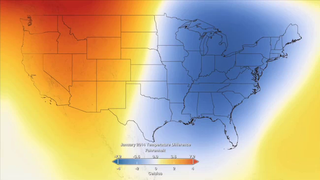Earth
ID: 4055
To determine the density of green on a patch of land, researchers must observe the wavelengths of visible and near-infrared sunlight reflected by the plants. The pigment in plant leaves, chlorophyll, strongly absorbs visible light (from 0.4 um - 0.7 um). Vegetation strongly reflects near-infrared light (from 0.7 -1.0 um). The more healthy leaves a plant has, the more the the visible light will be absorbed and the near-infrared will be reflected. In this animation, dark green indicates dense, healthy vegetation, whereas beige areas represent bare soil. Snow from the MODIS instruments is overlaid on top.

Seasonal Vegetation and Snow Change

Related
Visualization Credits
Lori Perkins (NASA/GSFC): Lead Animator
Michelle Handleman (USRA): Producer
Jefferson Beck (USRA): Producer
Compton Tucker (NASA/GSFC): Scientist
Patrick Lynch (Wyle Information Systems): Writer
Michelle Handleman (USRA): Producer
Jefferson Beck (USRA): Producer
Compton Tucker (NASA/GSFC): Scientist
Patrick Lynch (Wyle Information Systems): Writer
Please give credit for this item to:
NASA's Goddard Space Flight Center Scientific Visualization Studio
NASA's Goddard Space Flight Center Scientific Visualization Studio
Short URL to share this page:
https://svs.gsfc.nasa.gov/4055
Mission:
Terra
Data Used:
Note: While we identify the data sets used in these visualizations, we do not store any further details nor the data sets themselves on our site.
This item is part of this series:
MODIS Daily Snow
Keywords:
DLESE >> Biology
DLESE >> Ecology
GCMD >> Earth Science >> Climate Indicators
NASA Science >> Earth
GCMD keywords can be found on the Internet with the following citation: Olsen, L.M., G. Major, K. Shein, J. Scialdone, S. Ritz, T. Stevens, M. Morahan, A. Aleman, R. Vogel, S. Leicester, H. Weir, M. Meaux, S. Grebas, C.Solomon, M. Holland, T. Northcutt, R. A. Restrepo, R. Bilodeau, 2013. NASA/Global Change Master Directory (GCMD) Earth Science Keywords. Version 8.0.0.0.0
https://svs.gsfc.nasa.gov/4055
Mission:
Terra
Data Used:
Terra and Aqua/MODIS/Pixel Reliability (value=2) also referred to as: Ice and Snow
Analysis - 1/2008 - 6/25/2010Aqua/MODIS/NDVI
Data Compilation - 1/2008-6/25/2010This item is part of this series:
MODIS Daily Snow
Keywords:
DLESE >> Biology
DLESE >> Ecology
GCMD >> Earth Science >> Climate Indicators
NASA Science >> Earth
GCMD keywords can be found on the Internet with the following citation: Olsen, L.M., G. Major, K. Shein, J. Scialdone, S. Ritz, T. Stevens, M. Morahan, A. Aleman, R. Vogel, S. Leicester, H. Weir, M. Meaux, S. Grebas, C.Solomon, M. Holland, T. Northcutt, R. A. Restrepo, R. Bilodeau, 2013. NASA/Global Change Master Directory (GCMD) Earth Science Keywords. Version 8.0.0.0.0












